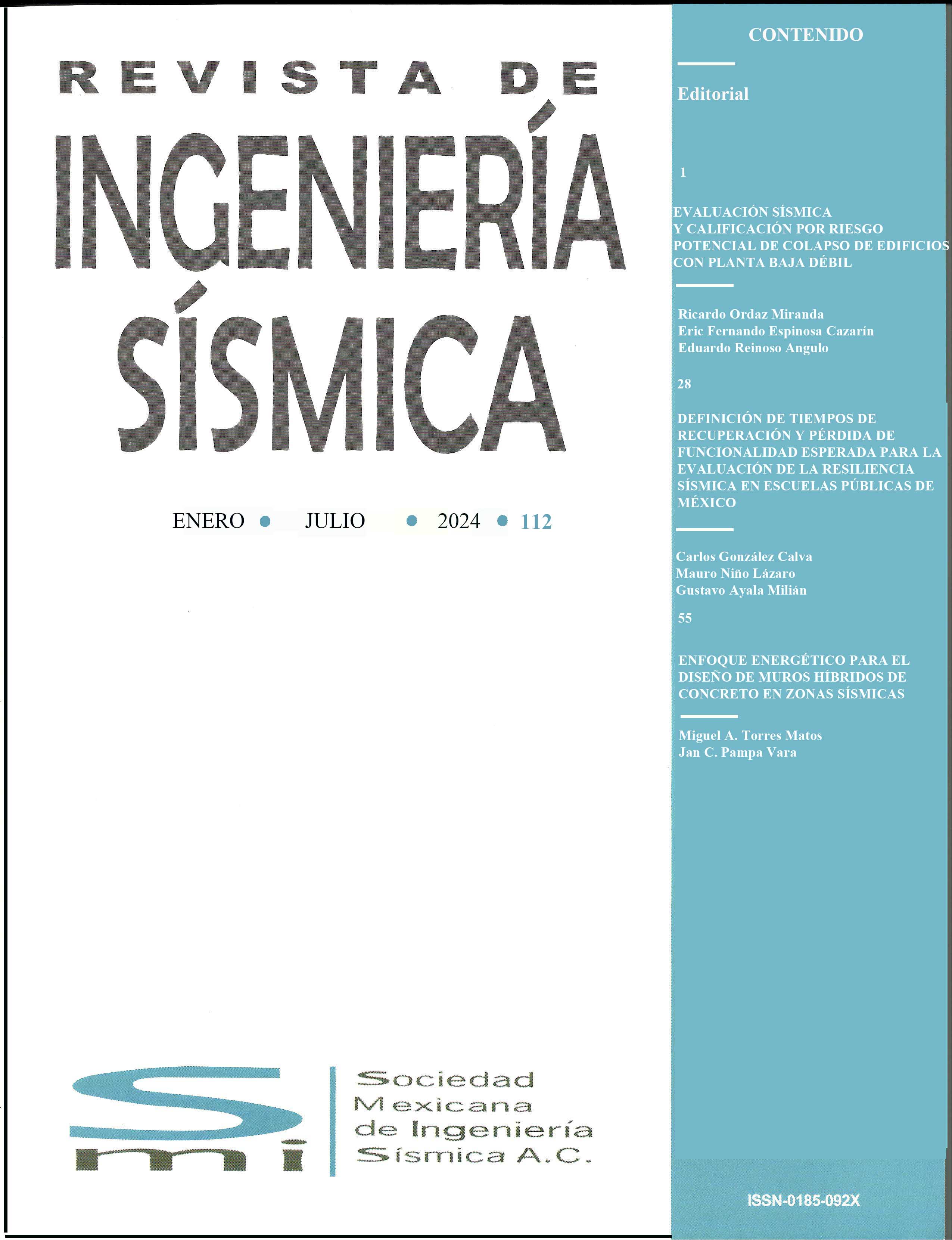RESPUESTA SÍSMICA INELÁSTICA DE MARCOS DE ACERO RESISTENTES A MOMENTO CON CONEXIONES RÍGIDAS Y SEMI-RÍGIDAS
DOI:
https://doi.org/10.18867/ris.64.201Resumen
Se obtiene analíticamente la respuesta sísmica inelástica de marcos de acero resistentes a momento con conexiones perfectamente rígidas (PR) y se compara con la respuesta de marcos de acero similares con conexiones semi-rígidas (SR). Se utilizan diferentes niveles de la rigidez de la conexión. La respuesta estructural, en términos de los desplazamientos máximos de entrepiso y el
cortante basal máximo, se estima usando un programa de cómputo desarrollado por los autores y otros miembros de un grupo de investigación. El programa considera las no linealidades geométrica, del material y la producida por las conexiones SR. Los resultados demuestran que el cortante basal máximo puede aumentar significativamente conforme se incrementa la rigidez de las
conexiones. Por el contrario, los desplazamientos de entrepiso máximos no siempre se incrementan cuando las conexiones se hacen más flexibles, como pudiera esperarse para el caso de aplicación de carga estática. Aun cuando la rigidez del marco con conexiones SR es menor que la del marco con conexiones PR, la respuesta ante carga sísmica depende significativamente de las características dinámicas tanto de la estructura como de la excitación sísmica. Cuantitativamente, los resultados confirman lo observado en estudios experimentales en forma cualitativa: las conexiones semirígidas
disminuyen la rigidez global de la estructura pero a su vez constituyen una fuente importante de disipación de energía. Por lo anterior, la respuesta sísmica puede ser mas favorable para marcos con conexiones SR que para marcos con conexiones PR. Sin embargo, se debe proveer un comportamiento estable de las conexiones durante los ciclos de carga y descarga.
Descargas
Citas
Bathe, K. J. (1982). Finite Element Procedures in Engineering Analysis, Prentice-Hall, Inc., Englewood Cliffs, New Jersey.
Clough, R.W. and Penzien J. (1993). Dynamics of Structures, 2nd edition, McGraw Hill, New York, N. Y.
Chopra, A. K. (1995). Dynamics of Structures: Theory and Applications to Earthquake Engineering, Prentice Hall, Englewood Cliff, New Jersey.
Disque, R O. (1964). “Wind Connections with Simple Framing”, Engineering Journal, AISC, Vol. 1, No 3, 101-103.
Elnashai, A. S., Elghazoulli, A.Y. and Denesh-Ashtiani, F.A. (1998), “Response of Semi-Rigid Steel Frames to Cyclic and Earthquake Loads,” Journal of Structural Engineering, Vol. 124, No. 8, pp. 857-867, August.
El-Salti, M.K., (1992). “Design of Frames with Partially Restrained Connections”, PhD Tesis, Department of Civil Engineering and Engineering Mechanics, University of Arizona.
Haldar, A. and Nee, K-M. (1989). “Elasto-Plastic Large Deformation Analysis of PR Steel Frames for LRFD”, International Journal of Computer and Structures, Vol. 34, Nº 5, 811-823.
Kondoh, K. and Atluri, S. N. (1987).“Large Deformation, Elasto-Plastic Analysis of Frames Under Non-Conservative Loading, Using Explicitly Derived Tangent Stiffness Based on Assumed Stress”, Computer Mechanics, Vol. 2, Nº 1, 1-25.
Leon, R. T. and Shin, K. J. (1995). “Performance of Semi-Rigid Frames, ”Proceedings of Structure Congress ASCE”, pp. 1020-1035, April.
Leger, P. and Dussault, S. (1992). “Seismic-Energy Dissipation in MDOF Structures”, Journal of Structural Division, ASCE, Vol. 118, Nº 5, 1251-1269.
Mahadevan, S. and Haldar, A. (1991). “Stochastic FEM-Based Evaluation of LRFD”, Journal of the Structural Engineering Division, ASCE, Vol. 117, Nº 5, 1393-1412.
Nader, M.N. and Astaneh, A. (1991). “Dynamic Behavior of Flexible, Semi-rigid and Rigid Frames,” Journal of Constructional Steel Research, Vol. 18, 179-192.
Owen, O. R. and Hilton, E. (1982). Finite Element in Plasticity: Theory and Practice, Pineridge Press Limit, Swansea, U. K.
Reyes-Salazar, A. and Haldar, A. (1999). “Nonlinear Seismic Response of Steel Structures with Semi-rigid and Composite Connections”, Journal of Constructional Steel Research, Vol. 51, No. 1, 37-59.
Reyes-Salazar, A. and Haldar, A. (2000). “Dissipation of Energy in Steel Frames with PR Connections”, Structural Engineering and Mechanics, An International Journal, Vol. 9, No. 3, 241-256.
Reyes-Salazar, A. (1997). “Inelastic Seismic Response and Ductility Evaluation of Steel Frames with Fully, Partially Restrained and Composite Connections”, Department of Civil Engineering and Engineering Mechanics, PhD. Thesis, University of Arizona.
Richard R M. and Abbott B. J. (1975). “Versatile Elastic-plastic Stress-strain Formula,” Journal of Engineering Mechanics Division, ASCE, Vol. 101, 511-525.
Roeder, C. W, Stephen, P. S., and James E. C. (1993). “Seismic Behavior of Moment-Resisting Frames: Analytical Study”, Journal of Structural Engineering Division, ASCE, Vol. 119, Nº 6, 1866-1883.






